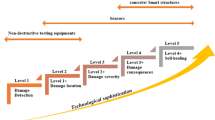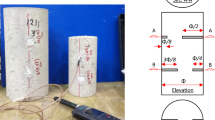Abstract
This paper deals with the development of concrete water content measuring devices for nuclear civil structures. It proposes a theoretical method to estimate the measurement uncertainty of the monitoring system needed to improve the predictions of the long-term behavior of prestressed concrete containment structures. Assuming a basic model for concrete drying, the errors regarding its parameters calibration when using different sensors arrangements are compared to figure out what are the most suitable systems and what are the devices specifications needed to actually improve the predictions. It turns out that current water content monitoring device should be improved to get a better benefit to containment ageing management. In particular, the measurement uncertainty should be enhanced to enable more relevant concrete creep prediction at the end of containment building lifetime. However, an extensive spatial sampling of the moisture profiles can compensate somehow current lack of water content devices for concrete monitoring.







Similar content being viewed by others
References
H. Abrishami et al., ‘Bonded or Unbonded Technologies for Nuclear Reactor Prestressed Concrete Containments’, Organisation for Economic Co-Operation and Development, NEA-CSNI-R--2015–5, 2015.
Courtois A, Taillade F, Placko D (2020) Some considerations on the benefit of measuring concrete moisture to predict long term structural behaviour’. Constr Build Mater 265:120283
Ayano T, Wittmann FH (2002) Drying, moisture distribution, and shrinkage of cement-based materials. Mater Struct 35(3):134–140. https://doi.org/10.1007/BF02533581
Samouh H, Rozière E, Loukili A (2018) Shape effect on drying behavior of cement-based materials: mechanisms and numerical analysis. Cem Concr Res 110:42–51. https://doi.org/10.1016/j.cemconres.2018.05.003
Oxfall M, Johansson P, Hassanzadeh M (2016) Long-term hygrothermal performance of nuclear reactor concrete containments – Laboratory evaluations of measurement setup, in situ sampling, and moisture flux calculations. Cem Concr Compos 65:128–138. https://doi.org/10.1016/j.cemconcomp.2015.10.012
Courtois A, Taillade F, Moreau G, Clauzon T, Skoczylas F, Masson B (2013) ‘Water Content Monitoring for Nuclear Concrete Buildings: Needs, Feedback and Perspectives’, presented at the 5th Biot conference on poromechanics, Vienna. Austria. https://doi.org/10.1061/9780784412992.195
Guihard V, Taillade F, Balayssac J-P, Steck B, Sanahuja J, Deby F (2017) ‘Modelling the behaviour of an open-ended coaxial probe to assess the permittivity of heterogeneous dielectrics solids’, in. Progress In Electromagnetics Research Symposium-Spring (PIERS) 2017:1650–1656
J. L. Adia, L. Charpin, B. Martin, D. Leroy, B. Masson, and A. Courtois (2019) ‘In-situ RH measurements in concrete in a variable temperature environnement’, Fram.-X Bayonne Fr.
Grasley ZC, Lange DA, D’Ambrosia MD (2006) Internal relative humidity and drying stress gradients in concrete. Mater Struct 39(9):901. https://doi.org/10.1617/s11527-006-9090-3
Jaafri R, Samouh H, Roziere E, Alam SY, Wisniewski V, Loukili A (2019) Experimental and numerical analysis of curling behavior of natural hydraulic lime - cement based mortars. Cem Concr Res 117:1–15. https://doi.org/10.1016/j.cemconres.2018.11.016
G. Moreau et al., (2011) ‘Survey of the future concrete structures lifetime measuring the water content: 4 types of embedded sensor under checking’, presented at the Contribution of materials investigations to improve the safety and performance of LWRs, Avignon, France
A. Courtois, T. Clauzon, F. Taillade, and G. Martin (2015) ‘Water Content Monitoring for Flamanville 3 EPR TM Prestressed Concrete Containment: an Application for TDR Techniques’, presented at the NDT-CE 2015, Berlin, Germany
Oukhemanou E, Desforges S, Buchoud E, Michel-Ponnelle S, Courtois A (2016) VeRCoRs Mock-Up: Comprehensive monitoring system for reduced scale containment model. France, Paris
Bazant ZP, Wittmann FH, Kim J-K, Alou F (1987) Statistical extrapolation of shrinkage data-Part I: Regression. ACI Mater J 84(1):20–34
Bazant ZP, Kim J-K, Wittmann FH, Alou F (1987) Statistical extrapolation of shrinkage data-Part II: Bayesian updating. ACI Mater J 84(2):83–91
Samouh H, Rozière E, Loukili A (2017) Influence of specimen size and measurements duration on the long-term extrapolation of drying shrinkage. Constr Build Mater 150:276–286
Brun R, Reichert P, Künsch HR (2001) Practical identifiability analysis of large environmental simulation models. Water Resour Res 37(4):1015–1030
M. Lecollinet, ‘Elaboration of Models for the Interaction Between the Sensor and its Environment’, in Fundamentals of Instrumentation and Measurement, John Wiley & Sons, Ltd, 2010, pp. 361–413. https://doi.org/10.1002/9780470612026.ch9
ISO, ‘ISO/IEC Guide 98–3:2008’. ISO, 2008
L. Ljung, System Identification: Theory for the User, 2nd edition. Pearson, 1998.
L. Charpin and A. Courtois, ‘Calibration of Mensi/Granger constitutive law: evidences of ill-posedness and practical application to VeRCoRs concrete’, in TINCE 2018, Massy-Palaiseau, France, Sep. 2018, p. 10
Torrenti JM, Granger L, Diruy M, Genin P (1999) Modeling concrete shrinkage under variable ambient conditions. Mater J 96(1):35–39. https://doi.org/10.14359/425
Bouhjiti DE-M, Boucher M, Briffaut M, Dufour F, Baroth J, Masson B (2018) Accounting for realistic Thermo-Hydro-Mechanical boundary conditions whilst modeling the ageing of concrete in nuclear containment buildings: Model validation and sensitivity analysis. Eng Struct 166:314–338
ESI Group, Scilab 5.5.2. 2017. Accessed: Mar. 07, 2019. [Online]. Available: https://www.scilab.org/
D. Vautrin, T. Clauzon, A. Courtois, and F. Taillade (2015) ‘Water content distribution in concrete using the FDR method’, presented at the 11th International Conference on Nondestructive Evaluation, Jeju Island (Korea)
Badr J et al (2019) Design and validation of a multi-electrode embedded sensor to monitor resistivity profiles over depth in concrete. Constr Build Mater 223:310–321
Ma X, Carette J, Benboudjema F, Bennacer R (2020) Optimization of experiment methodology based on identification of parameters in concrete drying. Constr Build Mater 256:119421
Acknowledgements
This work has been performed during the PhD thesis of Alexis COURTOIS funded by Electricité de France (EDF). The authors thank their colleagues from SATIE laboratory, at Ecole Normale Supérieure de Paris- Saclay, who provided advices and expertise that greatly assisted the research. The authors are also grateful for the insightful comments offered by the reviewers.
Funding
This study was funded by EDF France, more specifically by DTG Department (Grenoble).
Author information
Authors and Affiliations
Corresponding author
Ethics declarations
Conflict of interest
The authors have no financial or proprietary interests in any material discussed in this article.
Additional information
Publisher's Note
Springer Nature remains neutral with regard to jurisdictional claims in published maps and institutional affiliations.
Rights and permissions
About this article
Cite this article
Courtois, A., Taillade, F. & Placko, D. Optimization of sensor location and method analyzing for in-situ monitoring of concrete containment structures: a case involving embedded moisture sensors. Mater Struct 55, 77 (2022). https://doi.org/10.1617/s11527-022-01915-x
Received:
Accepted:
Published:
DOI: https://doi.org/10.1617/s11527-022-01915-x




